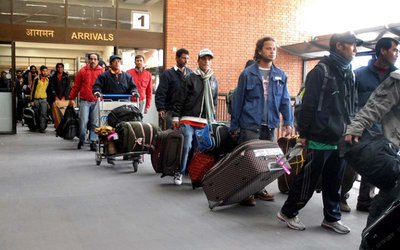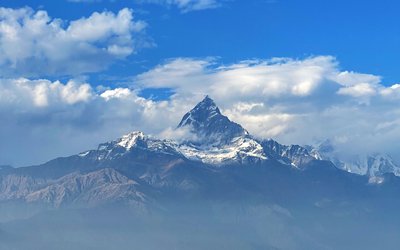Indeed the earthquakes that started on April 25 has united the whole nation in that major parties commanding more than two- thirds majority in the house struck a 16-point deal on the main contested issues, which seemed to have paved ways for promulgating the much awaited new constitution. The four major parties agreed that the country would be federated into eight provinces based on economic viability and identity. The four parties also decided to charge the commission to be formed by the government with the task of delineating the eight provinces which will be named by the provincial assemblies. The ruling parties also agreed on the opposition’s proposal that 60 percent be elected directly and 40 percent under the proportional representation system in the lower house of the parliament. Notwithstanding strong resentment of some Madesh-centric parties that went to the extent of expelling Gachhadar, one of the four signatories, from their Front and the very controversial decision of the Supreme Court staying enforcement of the sixteen point deal, the Constitution Drafting Committee began work, after receiving consent of the Dialogue Committee, and prepared the first draft of the constitution, on the basis of the deal, for presentation in the CA. Despite some hiccups, the draft has been tabled at the CA full House for deliberation. The much awaited document has been made public and the deliberation on it in the CA plenary will start on Thursday (July 2, 2015).The draft has to be circulated amongst public for garnering suggestions from the mass before its finalization and promulgation by the CA.This is a positive development. Good that the Maoists led by Prachanda have registered disagreement on some issues such as parliamentary system but have wisely decided not to obstruct promulgation of the new constitution. Although UML party wants the new constitution within mid-July following a fast track approach, nothing has been said by the concerned parties about time-table of constitution promulgation and formation of national unity government that UML chairperson K P Oli is hopeful of leading. It is definitely a positive sign that constitution preparation work is proceeding unhindered despite hurdles of different nature coming from different quarters.
The two major parties ,NC and UML, have differed vehemently on certain issues such as formation of a national unity government prior to new constitution primarily to carry out the gigantic task of reconstruction following massive devastation caused by the earthquake. NC, however, stuck to his earlier position of handing over the government leadership only after the promulgation of constitution and finally emerged victorious when Prachanda ,who people thought had sided with UML in changing the leadership of the government, expressed his reluctance to accord more importance to anything other than constitution preparation. The alliance of opposition parties had clearly told Maoist Supreme to concentrate on resolving contentious issues through consensus rather than talking about formation of a consensus government. The two coalition partners also differed on the formation of a powerful body to handle reconstruction activities in the earthquake devastated areas. While NC wanted the ordinance on the body to be passed before the international donors’ meeting scheduled for June 25,UMl wanted it to be discussed in the regular session of the Parliament that was convening soon. However, after some rounds of discussion between stalwarts of two parties, the cabinet cleared the ordinance to be placed before the President who wasted no time to approve it, allowing the government to tell donors that they had made necessary arrangements to reconstitute a body to carry out activities using money to be donated by friendly nations and agencies. Notwithstanding differences that surface between the two parties intermittently, the leaders and the two parties have remained united on major issues of national importance such as those related to constitution and the need to mobilize resources globally for reconstruction. It is indeed a positive sign that the two major parties decided to patch up their differences at least temporarily, if not for ever, before the major event.
It would not be an exaggeration if one opines that Nepal got aid pledges beyond expectation by donor community and development partners when their representatives rubbed shoulders with dignitaries of Nepal on June 25.Indeed, $ 4.4 billion pledged, half grant and half concessional loan, was a pleasant surprise not only for Nepal’s decision maker but also commoners who had begun to believe that international donors were not being generous to help Nepal even at this very difficult time. The Post Disaster Needs Assessment suggested that $ 6.7 will be required for reconstruction and government officials and ministers had hoped to secure pledges of around $3 billion. India and China made substantial commitments to their neighbor commensurate with their rising economic strength and political clout in global affairs and multilateral bodies such as the World Bank and the Asian Development Bank did not lag behind in making firm commitments to help their member country. The assembled donors gave a positive and firm hint that they will not let this country face resource constraints in carrying out reconstruction activities as long as the funds made available are properly and timely used in a transparent manner.
Nepal is often accused of not being able to spend on time the money given to it because it does not have the capacity, referred to as capacity constraints, to do so. Special efforts will have to be made and serious attention paid to doing away with theses constraints. In the event of Nepal Government failing to do so, a huge gap between pledging and actual disbursement is likely to surface and we will have none but our own government to blame then. It may also be useful to note that both foreign loan and grants are on a decline in recent times: foreign grants stood at Rs. 26.7 billion in the first week of Ashad as against Rs.34.5 billion in the last fiscal year and foreign loan stood at Rs.4.96 and Rs.14.96, respectively, during the two periods. In addition to capacity constraints, the decline in foreign loans and grants could be attributed to improvement in public debt/GDP ratio which in the last couple of years stands at less than 30 percent. Huge pledges of assistance have been showered upon us and we need to be very serious to create conditions to utilize it in an effective, efficient, transparent and sustainable way. Creation of the Authority without wasting much time and lesser squabbles amongst leaders over appointment of its officials could be the first step towards this. It is clear that serious injuries have been inflicted on our economy whose imports are ten times are higher than exports and import of rice is alarmingly on the rise in this agricultural country that exported rice to different countries in the past. In the 10 months of this fiscal, rice import increased by some Rs. 6 billion to reach Rs. 20 billion, compared to the corresponding period of last fiscal. It is heartening to learn that our government will be soon launching first paddy mission to boost both production and productivity to feed the growing population. Aiming to cover670, 000 hectares in 13 Tarai districts, the program intends to increase productivity from the current 3.17 tons per hectare to3.57 tons by the end of the third year, making Nepal self-reliant in rice. One would hope that similar programs be launched in other agro-climatic belts such as hills and mountains to increase production and productivity of livestock and horticultural products the demand of which to a large extent is met through imports. Total imports went up astronomically to reach Rs.628 billion, while exports remained peanuts at Rs. 70 billion in the 10 months of this fiscal year. A prudent combination of fiscal and monetary measures will have to be put in place to correct the trade imbalance. While moderate inflation (7.1 percent) and positive Balance of Payment Position(more than Rs.100 billion) allows Nepal Rastra Bank to inject liquidity into the economy at concessional rates, Ministry of Finance has the fiscal space(low public debt/gdp ratio, huge cash reserve positioned) to assist different sectors of the economy through subsidy and tax cuts. It is likely that if all the commitments made by the donors materialize, reconstruction and rehabilitation of quake-damaged infrastructure can be completed, letting Nepal Government use its internal resources to enhance production of different items ranging from food stuff to construction materials whose demand is likely to go up in the changed scenario. With reconstruction movement proceeding as envisaged and wanted by the donors and government supported sectorial production projects yielding output, economy could grow by anything between 6 to 7 percent in the next fiscal year. Those at the helm of affairs may also note that Natural calamities such as flood, landslides and drought that entail loss of lives and property are too common in Nepal and the governments over time have failed to adequately address the problem. After the earthquakes and their continuing aftershocks, people from different hilly areas have urged the government to resettle them, fearing land-slips of devastating nature during the ongoing monsoon season. Therefore, with no specialized agency in place to act effectively at such times, the proposed Reconstruction Authority may also be charged with the responsibility of disaster management that could include activities such as preventive measures, rescue, relief and resettlement of the affected families in cooperation with government line agencies. This way, the Authority will have important responsibility to discharge on a regular basis even after completion of the 5 year period allocated for reconstruction and rehabilitation of the earthquake-damaged infrastructures. Hope the rumored complications of serious political nature do not obstruct and impede the nation building task that we intend to embark upon.

Dr. Tilak Rawal
Dr. Rawal is former governor of NRB.
- Chaotic Nepal -II
- Jun 23, 2025
- Six Months Of Deuba And Oli
- Jan 25, 2025
- Prachanda Outsmarted
- Jul 19, 2024
- Prachanda Outsmarts Again
- Apr 14, 2024
- Prachanda Completes One Year
- Jan 26, 2024












